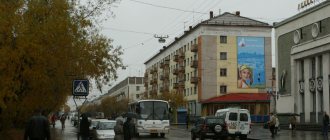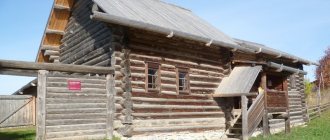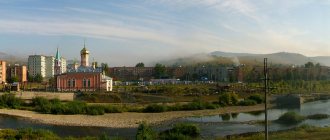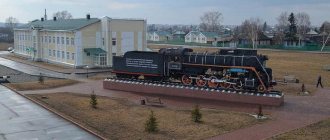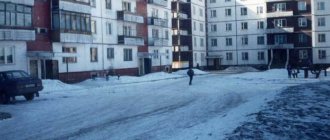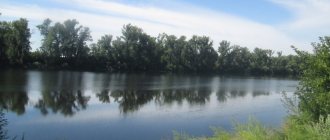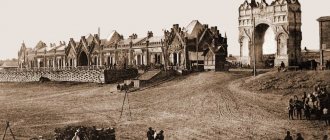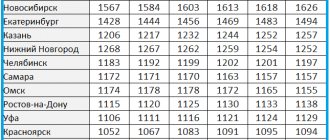City in Komi Republic, Russia
| Emva Emva | |
| City [1] | |
| Other transcription(s) | |
| • Komi | Emva |
| View of Emva | |
| Coat of arms | |
| Location of Yemva | |
| Emva Location of Yemva Show map of Russia Emva Emva (Komi Republic) Show map of the Komi Republic | |
| Coordinates: 62°36'N 50°52'E / 62.600°N W. 50.867°E / 62,600; 50.867 Coordinates: 62°36'N 50°52'E. / 62.600°N 50.867°E / 62.600; 50.867 | |
| A country | Russia |
| Federal subject | Komi Republic [1] |
| Administrative region | Knyazhpogost district [1] |
| City of District significance Administrative territory | Emva [1] |
| Based | 1930s |
| City status from | 1985 |
| population size (2010 Census) [2] | |
| • General | 14 570 |
| • Evaluate (2018) [3] | 12 630 ( -13,3% ) |
| Administrative status | |
| • Capital from | Knyazhpogost district [1], Yemva, significant district, administrative territory [1] |
| Municipal status | |
| • Municipal district | Knyazhpogostsky municipal district [4] |
| • Urban village | Emvinskoe urban settlement [4] |
| • Capital from | Knyazhpogost municipal district [4], urban settlement Yemva [4] |
| Timezone | UTC+3 (MSK[5]) |
| Postal code [6] | 169200–169203 |
| OKTMO ID | 87608101001 |
Emva
(Russian: Емва, Komi: Емва) is a city and the administrative center of Knyazhpogostsky District in the Komi Republic, Russia, located on Vym 130 kilometers (81 mi) northeast of Syktyvkar. Population: 14,570 (2010 census); [2] 16,739 (2002 census); [7] 18,782 people (1989 census). [8]
Administrative and municipal status[edit]
As part of the administrative divisions, Yemva serves as the administrative center of the Knyazhpogostsky district. [1] As an administrative division, together with nine rural settlements it is part of the Knyazhpogostsky district as the city of
Yemva of a significant administrative district
.
[1] As a municipal entity, Yemva urban significant administrative territory is part of the Knyazhpogost municipal district as the urban settlement of Yemva
. [4]
Knyazhpogost and Yemva
The village of Knyazhpogost is located north of the capital of the Komi Republic - the city of Syktyvkar. Apparently, in the distant past, this place was the residence of the Vym princes who ruled Perm, Vychegda, which is why such a toponym arose. This is one of the oldest settlements on the Vym River.
Coordinates for GPS navigator
62.59860396215599, 50.887533093563555
Yemva city on the map
Archaeological finds indicate that people lived here for a long time. Near the village, traces of an ancient fortified settlement with ramparts and ditches were discovered. The first written mention of the village dates back to 1490.
The main attraction of the village of Knyazhpogost is the stone Church of the Assumption of the Blessed Virgin Mary, built in 1830. Or rather, what's left of it. Currently, the church is not active and is a ruin. The ancient temple is gradually being destroyed; one of its walls recently collapsed.
On the other side of the Vym River, on its right bank, is the regional center of the Knyazhpogostsky district - the city of Yemva. The city got its name from the local name of the Vym River - Yemva (“sacred water”). This settlement is quite young, it arose in the 1930s, and was first called the village of Zheleznodorozhny. It became the city of Yemva in 1985.
In the recent past, it was one of the islands of the Gulag archipelago. It was the prisoners who built the Syktyvkar-Knyazhpogost highway and the railway. The administration of Sevzheldorlag was located in the village of Zheleznodorozhny. The Northern railway camp existed from 1938 to 1950, the number of prisoners reached 85 thousand people.
The Sevzheldorlag administration building was built by the Chinese. This is probably why it looks a little like a Chinese pagoda. The two-story wooden camp administration building, built in 1937, has survived to this day. After the camp was liquidated in 1949, it housed a secondary school and then a vocational school. The building is currently abandoned.
Another reminder of Stalin’s repressions is the building of the primary school in the settlement of special settlers Vyl-Ordym. In the 1960s, the building was transported to Zheleznodorozhny, and now the sports complex of the city of Yemva is located within its walls. In 2003, a public museum of the History of Repression was created in Yemva on the territory of the Knyazhpogost district. This is one of the best museums in the Komi Republic dedicated to the theme of the Gulag. It occupies three rooms in the House of Children's Creativity. Museum address: Yemva, st. Pionerskaya, 20.
The Knyazhpogost regional museum of history and local lore also operates in the city of Yemva. The museum was founded back in 1969 on a voluntary basis, and in 1990 it was transferred to the state. The museum is housed in a wooden two-story building built in the 1930s and 40s (former military registration and enlistment office). The following exhibitions are presented: “Nature of the Knyazhpogost region”, “No one is forgotten, nothing is forgotten”, “Golden Gallery of Countrymen”, “Return of P.A. Sorokin”, “Models of sea vessels”. The theme of political repression is also explored.
By the way, Russians are in the minority in the Knyazhpogost region. Over 75% of the region's population are Komi. The population in the city of Yemva itself is about 15 thousand people. About 60-70 kilometers northeast of Yemva (near the Sindor station) Lake Sindorskoe is located - the second largest among all the lakes of the Komi Republic. This lake is a natural monument; a complex reserve has been created here. The lake is unique because of its moving islands - peat and plant floats wandering across the surface of the lake. The lake is rich in fish, and its bottom is composed of healing silt - sapropel.
How to get to the village of Knyazhpogost?
You can get to Yemva by car (Syktyvkar - Sosnogorsk highway) or by public transport: by bus Syktyvkar - Yemva, or by train. The Kotlas-Vorkuta railway (Knyazh-Pogost station) passes through Yemva, as well as the Syktyvkar-Sosnogorsk highway. The village of Knyazhpogost on the other side of the river can only be reached by boat. There is no road there.
Order now!
Your ad could be here!
https://nashural.ru Your advertisement will be seen by thousands of people a day
Interesting? Tell your friends!
Links[edit]
- ^ abcdefgh Law No. 13-RZ
- ^ a b Federal State Statistics Service (2011). “All-Russian Population Census 2010. Volume 1" [All-Russian Population Census 2010, vol. 1]. All-Russian Population Census 2010 [All-Russian Population Census 2010]
. Federal State Statistics Service. - "26. The size of the permanent population of the Russian Federation by municipalities as of January 1, 2022". Federal State Statistics Service. Retrieved January 23, 2022.
- ^ abcde Law No. 11-RZ
- "On the Calculation of Time". Official Internet portal of legal information
. June 3, 2011. Retrieved January 19, 2022. - Post office. Information and computing center of OASU RPO. ( Post office
).
Search for postal service objects ( postal Search for objects
) (in Russian) - ↑
Federal State Statistics Service of Russia (May 21, 2004).
“The population of Russia, the constituent entities of the Russian Federation as part of federal districts, urban settlements, settlements, settlements of 3 thousand or more people” [Population of Russia, its federal districts, federal districts, districts, urban settlements, rural settlements - administrative centers and rural settlements with a population of more than 3,000 people] (XLS). All-Russian Population Census 2002
. - “All-Union Population Census of 1989. The current population of union and autonomous republics, autonomous regions and districts, territories, negative phenomena, urban settlements and rural district centers” [All-Union Population Census of 1989: current population of union and autonomous republics, Autonomous regions and districts , territories, regions, districts, towns and villages performing the functions of district administrative centers. All-Union Population Census of 1989 [All-Union Population Census of 1989]
.
Institute of Demography of the National Research University: Higher School of Economics [Institute of Demography of the National Research University: Higher School of Economics]. 1989 - via Demoscope Weekly
. - “Information about the Emva team” Emva, Knyazhpogostsky district, Komi - Register - Russian Bandy Federation ". rusbandy.ru
.
Emva
(Komi Republic)
OKATO code:
87208501
Founded: Urban settlement since:
1941
City since:
1985 City of district subordination (Knyazhpogostsky district of the Komi Republic)
Center:
Knyazhpogostsky district
The city was formerly called:
| Railway | 1941 | 1985 |
| Telephone code (reference phone) | |
| 82139***** | 9-10-88 |
Deviation from Moscow time, hours:
0
Geographic latitude:
62°35′
Geographic longitude:
50°53′
Altitude above sea level, meters:
100 Sunrise and sunset times in the city of Yemva
Excerpt characterizing Yemva
Hearing this indifferent voice, Rostov was afraid of what he was doing; the thought of meeting the sovereign at any moment was so tempting and therefore so terrible for him that he was ready to flee, but the chamberlain Fourier, who met him, opened the door to the duty room for him and Rostov entered. A short, plump man of about 30, in white trousers, over the knee boots and one cambric shirt, apparently just put on, stood in this room; the valet was fastening a beautiful new silk-embroidered belt on his back, which for some reason Rostov noticed. This man was talking to someone who was in another room. “Bien faite et la beaute du diable, [Well-built and the beauty of youth," this man said, and when he saw Rostov he stopped talking and frowned. -What do you want? Request?... – Qu'est ce que c'est? [What is this?] - someone asked from another room. “Encore un petitionnaire, [Another petitioner,”] answered the man with the help. - Tell him what's next. It's coming out now, we have to go. - After the day after tomorrow. It’s too late... Rostov turned and wanted to leave, but the man in the arms stopped him. - From whom? Who are you? “From Major Denisov,” Rostov answered. - Who are you? Officer? - Lieutenant, Count Rostov. - What courage! Give it on command. And go, go... - And he began to put on the uniform handed to him by the valet. Rostov went out again into the hallway and noticed that there were already many officers and generals on the porch in full dress uniform, whom he had to pass by. Cursing his courage, frozen by the thought that at any moment he could meet the sovereign and in his presence be disgraced and sent under arrest, fully understanding the indecency of his act and repenting of it, Rostov, with downcast eyes, made his way out of the house, surrounded by a crowd of brilliant retinue , when someone's familiar voice called out to him and someone's hand stopped him. - What are you doing here, father, in a tailcoat? – his bass voice asked. This was a cavalry general who earned the special favor of the sovereign during this campaign, the former head of the division in which Rostov served. Rostov fearfully began to make excuses, but seeing the good-naturedly playful face of the general, he moved to the side and in an excited voice conveyed the whole matter to him, asking him to intercede for Denisov, who was known to the general. The general, after listening to Rostov, seriously shook his head. - It’s a pity, it’s a pity for the fellow; give me a letter. Rostov barely had time to hand over the letter and tell Denisov’s whole business when quick steps with spurs began to sound from the stairs and the general, moving away from him, moved towards the porch. The gentlemen of the sovereign's retinue ran down the stairs and went to the horses. Bereitor Ene, the same one who was in Austerlitz, brought the sovereign's horse, and a light creak of steps was heard on the stairs, which Rostov now recognized. Forgetting the danger of being recognized, Rostov moved with several curious residents to the porch itself and again, after two years, he saw the same features he adored, the same face, the same look, the same gait, the same combination of greatness and meekness... And the feeling of delight and love for the sovereign was resurrected with the same strength in Rostov’s soul. The Emperor in the Preobrazhensky uniform, in white leggings and high boots, with a star that Rostov did not know (it was legion d'honneur) [star of the Legion of Honor] went out onto the porch, holding his hat under his hand and putting on a glove. He stopped, looking around and illuminating everything around him with his gaze. He said a few words to some of the generals. He also recognized the former chief of the division, Rostov, smiled at him and called him over. The entire retinue retreated, and Rostov saw how this general said something to the sovereign for quite a long time. The Emperor said a few words to him and took a step to approach the horse. Again the crowd of the retinue and the crowd of the street in which Rostov was located moved closer to the sovereign. Stopping by the horse and holding the saddle with his hand, the sovereign turned to the cavalry general and spoke loudly, obviously with the desire for everyone to hear him. “I can’t, general, and that’s why I can’t because the law is stronger than me,” said the sovereign and raised his foot in the stirrup. The general bowed his head respectfully, the sovereign sat down and galloped down the street. Rostov, beside himself with delight, ran after him with the crowd. On the square where the sovereign went, a battalion of Preobrazhensky soldiers stood face to face on the right, and a battalion of the French Guard in bearskin hats on the left.
Geography
The city of Yemva is the administrative center of the Knyazhpogost municipal district and is located on the left bank of the Vym River, 122 km from Syktyvkar. The nearest railway station is Knyazhpogost (Northern Railway) located in the city center. The station received its name from the name of the village of Knyazhpogost, located on the opposite bank of the Vym River, opposite the city.
The city consists of a “center” and suburbs - the microdistricts Achim, Novy, Severny and the 20th and 21st microdistricts, which received their names from the numbering of the Gulag camps. The Prince Pogost is mentioned quite often in the work “The Gulag Archipelago” by A. I. Solzhenitsyn.
The city stretches along the railway for 10 kilometers. Along the railway track there is a highway connecting the microdistricts.
In the center of the city there is a House of Culture, a music school (in the building of the former district committee of the CPSU), a bus station and a railway station. In the city there are 2 secondary schools No. 1 and No. 2 and one incomplete secondary school, Achimskaya. The Knyazhpogostsky Mechanical Plant and the Fiberboard Plant, which were the industrial basis before perestroika, are currently closed and dilapidated. The local population works mainly in trade, taxis, security guards at correctional facilities, and in the public sector.
The Knyazhpogost Republican Military Commissariat is engaged in collecting conscripts for the Armed Forces from all over the territory of the Komi Republic.
The city market is represented by 2 retail spaces - the building of a former department store, which now houses shopping arcades, and an open-air trading market.
